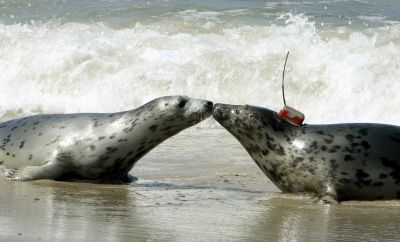Europe's Baltic Sea: a vulnerable ecosystem

With their heads bobbing out of holes in the winter ice, six grey seals are pioneering the re-population of their species along Poland's Baltic Sea coast.
"We don't know all the reasons why seals vanished from Poland's Baltic coast," says Iwona Pawliczka, a biologist at Gdansk University's marine research station on Poland's Hel peninsula.
"A century ago there were about 100,000 grey seals in the Baltic. In the 1980's their population fell to 2-3,000," she explains, adding that hunting and chemical pollutants that rendered females infertile decimated populations.
While colonies in the northern Baltic near Sweden are now about 20,000-strong, Pawliczka says just a few dozen seals, most of them offspring bred at the Hel station, live along Poland's entire Baltic coast.
Female seals Ania, Eva, Agata who arrived in Hel from Estonia, and Unda Marina from Sweden are now all pregnant with a new generation.
The fate of the Harbour Porpoise, a small dolphin once common across the Baltic, is even more precarious. Hunting, fishnets as well as chemical and noise pollution have all but wiped it out. With experts estimating that fewer than 250 remain in Baltic waters, in 2008 they were declared a critically endangered species.
Encircled by nine countries, including Estonia, Denmark, Finland, Germany, Latvia, Lithuania, Poland, Russia and Sweden, the Baltic has an estimated 16 million people living along its shores.
Experts note that as a relatively small, shallow and enclosed sea it has a very limited ability to flush out pollutants into the larger waters of the North Sea, making it an extremely vulnerable ecosystem.
Senior leaders from Baltic states are to meet Wednesday in Helsinki to save what organisers say is one of the world's most threatened seas.
A computer screen glowing with satellite tracking of vessels across the Baltic reveals intense traffic, with in excess of an estimated 2,000 ships on its waters on any given day.
"We're lucky we've never had a major fuel spill on the Baltic and it is being precisely monitored to keep it that way," says Port of Gdynia harbour master Andrzej Kaleta.
Several flights out of Gdynia each week are focused on finding contamination from shipping in Polish territorial waters.
However, older environmental hazards are surfacing. Last week, Sweden's SVT public television aired allegations that Russia dumped chemical weapons and radioactive waste off the shores of the Swedish Baltic island of Gotland between 1991-94.
Controversy has also raged over the possible negative environmental impact of the NordStream natural gas pipeline Russia and Germany plan to build across the Baltic Sea floor.
But according to University of Gdansk marine biologist Professor Maciej Wolowicz, a complex organic process sucking the oxygen out of the Baltic is perhaps the greatest hazard.
Oxygen-depletion caused by a process scientists term "eutrophication" occurs when an overdose of nutrients - including nitrates and phosphates from farm fertilisers and sewage - is washed into the sea.
These spark excessive algae growth which left unconsumed, lead to oxygen-depleted areas where no marine life can exist.
"It's like a 'desertification' of the Baltic Sea bed and it is relatively wide-spread," Wolowicz says.
He insists education is key to reversing the process.
"Law and regulations are essential, but if people have no or very limited awareness of how their actions affect the environment, regulations alone can't work," he insists.
Pioneering gravel extraction in the Baltic and planning a massive wind farm in an area where Swedish and Polish territorial waters meet, Mieczyslaw Twardowski says his company, Baltex, has no choice but to meet international environmental norms if it hopes to do business.
"The environmental impact of our activities is strictly monitored and as we are operating in an area requiring approval from Sweden, it is critical for our impact to be within acceptable norms," he told AFP recently.
Baltex is set to extract seven million tonnes of high quality gravel from the Baltic Sea floor over the next three years.
"We also want to erect 260 windmills, each with a six megawatt power capacity for a total 1,560 megawatts - the power of a nuclear reactor," Twardowski says of the 20-year project worth an estimated four billion euros (5.45 billion dollars) which he hopes to start in 2012.
Subscribe to Independent Premium to bookmark this article
Want to bookmark your favourite articles and stories to read or reference later? Start your Independent Premium subscription today.

Join our commenting forum
Join thought-provoking conversations, follow other Independent readers and see their replies